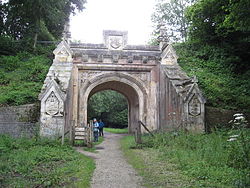Lady Wimborne Bridge
The Lady Wimborne Bridge (London and South Western Railway Bridge 77) is a former railway bridge built in 1853, and now a listed building. Its highly ornate design reflects the power of landowners over British railway companies in the mid-nineteenth century. Built shortly after the railway came to the town of Wimborne in Dorset, England, it is now a Grade II listed structure.[1]

Design
Although the Southampton and Dorchester Railway through Wimborne was authorized before Sir John Guest, 1st Baronet of Dowlais (one of the greatest iron founders of the time, his ironworks being situated in Dowlais, South Wales) took ownership of Canford Manor in 1846,[2] later negotiations with the company (of which Guest was a director) led after his death in 1852 to the replacement of the original structure with another over what became the carriage drive to the house.[3] The bridge was until recently attributed in the on-line version of the official listing to Charles Barry Jr., the highly regarded English architect of the mid to late 19th century, and eldest son of Sir Charles Barry.[4] However the latter was responsible for the extensive alterations to the manor around the time of the bridge’s construction and was in fact the designer.[5]
History
The bridge is probably named after the first Lady Wimborne (1847-1927), although it was her mother-in-law, Lady Charlotte Guest, Sir John's wife, who was responsible for financing the bridge's construction around 1853-54, after her husband died.[6] It is not clear when the bridge became known by its present name: contemporary newspaper reports from the 1850s do not identify it in this way.
The last train passed over the bridge on 3 May 1977, following the recovery of equipment from Wimborne station which had just closed to all traffic.
Although the railway is long gone, steep steps allow pedestrians to climb the embankment to the top and follow a footpath to the river or, in the other direction, along an informal path towards the site of the former Wimborne Junction and engine shed. Unfortunately the informative interpretation board located on the ground by the bridge has been removed.
References
- "Name: LADY WIMBORNE'S BRIDGE List entry Number: 1266681". Historic England. Retrieved 11 April 2016.
- R. Guest & A. V. John, Lady Charlotte: A Biography of the Nineteenth Century (Weidenfeld & Nicolson, 1989), pp.143-48.
- Minutes of the Southampton & Dorchester Railway Company (1845-47), Southampton City Archives.
- "LADY WIMBORNE'S BRIDGE". Historic England. Retrieved 26 April 2017.
- G. Biddle, Britain's Historic Railway Buildings: A Gazetteer of Structures and Sites (Ian Allan, 2nd edn 2011), pp.200-201; Salisbury & Winchester Journal (6 Sep. 1856, 3 Nov. 1860)
- "Lady Wimborne's Bridge, Oakley". British Listed Buildings. Retrieved 5 December 2016.